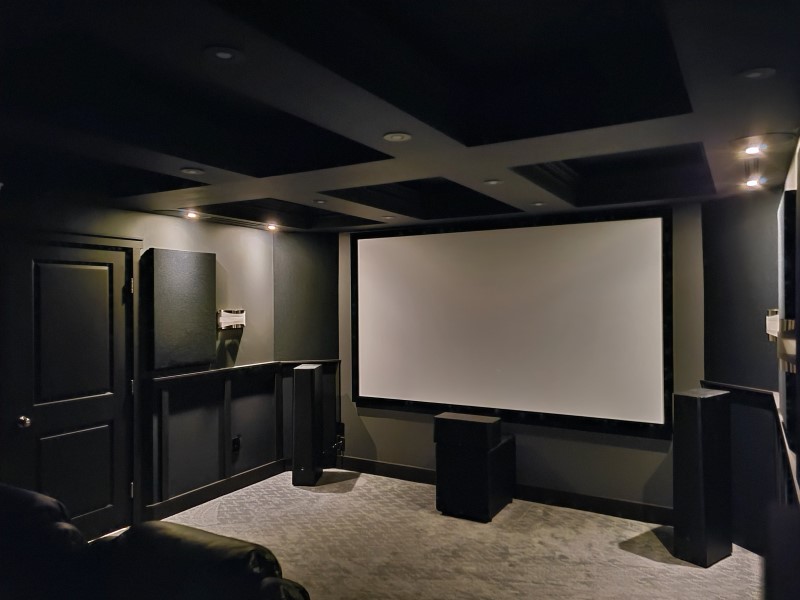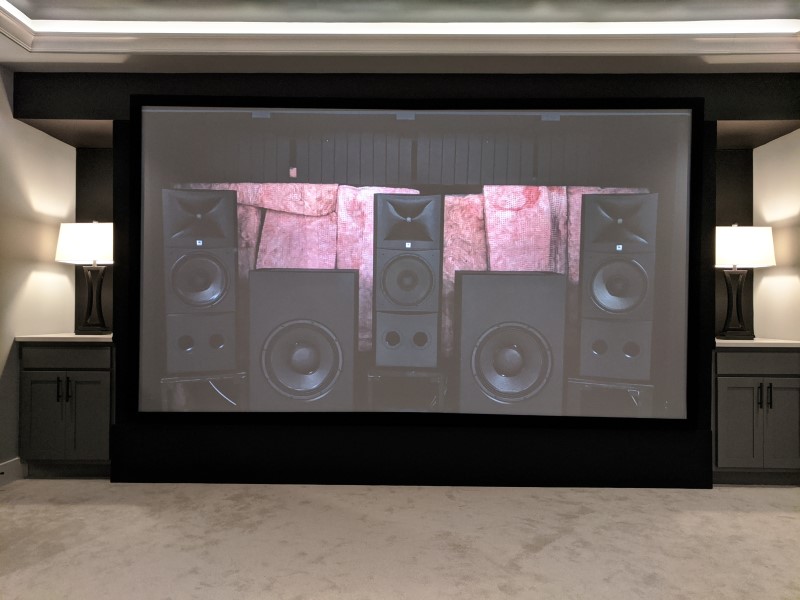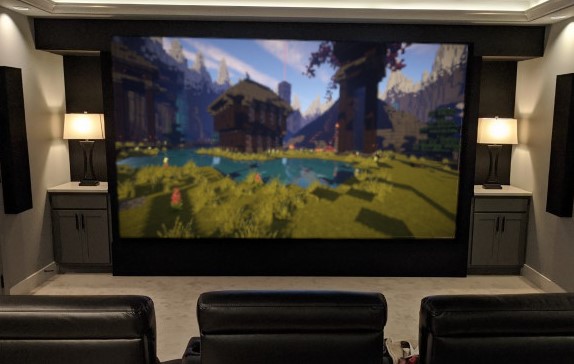Why You Shouldn’t Have a Projection Screen Larger than 135″
So getting a projector and screen makes it tempting to go as big as possible. Who wouldn’t want an IMAX experience at home? But the simple fact is that there are good reasons why you shouldn’t have a projection screen larger than 135″. Let’s discuss!
Reason 1: HDR (and math)
Ok, so I hate math, but I like HDR (or High Dynamic Range)! You need to have adequate light output for good HDR performance from a projector. Digital Cinema Initiative (DCI) specs require 30-34 foot-lamberts of light output to get proper HDR performance. Still with me?
Ok, to figure this out, you need to do some math. Take the square footage of your screen and divide it by the REAL number of lumens of your projector – it’s usually less than the spec sheet says. This number will tell you how many foot-lamberts you have. Guess what? Once you get past 135″, it becomes exceedingly difficult to hit that 30-34 foot-lamberts figure.

You will want to stick to a 1.0 gain screen if you want to maintain good HDR performance. But the bigger you get, the more gain you will need to keep that 30-34 foot-lamberts output. That means you will probably need a higher gain screen to maintain good brightness. Higher gain screens lead to hot-spotting, sparkling, poorer contrast, and other unwanted side effects.
So if you want good HDR output, this is one of the main reasons why you shouldn’t have a projection screen larger than 135″.
Reason 2: Speaker Placement
One of the reasons I don’t recommend a screen larger than 135″ is speaker placement. First, you have your center speaker. Ideally, your center speaker should be at ear height. For obvious reasons, most of us have it under the screen and angled up towards our ears. This placement works well for flat screen panels and moderate-size projector screens. But once you reach 135″, your center will get closer to the ground. Not ideal!

Same with your left and right speakers. As your screen expands, so does the distance between your two main speakers. Sure, you want adequate separation in your front sound stage, but there are limits. If your speakers are too wide apart, there will be a gap in your front soundstage. This gap will sound particularly pronounced in panning scenes.
One solution is to get an acoustically transparent screen and build a false wall. But acoustically transparent screens have their issues. Aside from the possibility of seeing the weave pattern, they are more expensive and tend to have more negative screen effects than their non-acoustically transparent brethren.

Reason 3: Throw Distance/Ratio
So this one is easy math. The bigger the screen, the more distance your projector needs to throw an image that big. Depending on the output of your projector, you may need even more space behind and around your projector for proper venting/cooling. For example, some 4k laser projectors require another 18-24″ behind them!
Plus, you will need a lot of light output (see reason 1) to get that screen to look good at that distance—more light=more expensive. So unless you have a huge room, this is another reason you shouldn’t have a projection screen larger than 135″.
Reason 4: Seating Distance From Screen
How far you sit away from the screen in the theater tells me a lot about your Field of View (FOV) preference. The Society of Motion Picture and Television Engineers (SMPTE) recommends a minimum of 30° FOV for a “good” experience. However, for a “theater” experience, the SMPTE recommends 40° FOV. If you tend to be in the front third of seats, closer to the screen, you like a FOV over 40°. The middle third tells me you want the cinematic FOV, and the back third tells me you like a smaller screen format.
“I get it, Andrew! Big screens are bad! Stop lecturing!” Ok, so I hate to keep droning on, but in this case, it’s not that big screens are bad. It’s that they are impractical and possibly detrimental. I prefer a FOV that falls within that 30° zone. I would need a much larger room to have a screen larger than 135″.

Being too close to a large screen can be overwhelming, cause eye strain, and even induce motion sickness. For example, I was in the front 1/3 of a sold-out IMAX theater. Not because I wanted to sit there, there were no other seats. So I left nauseous and with a cramp in my neck!
So unless you have a significantly sized room, or like sitting very close to a big screen, this is why you shouldn’t have a projection screen larger than 135″.
Reason 5: Larger Screen Means A More Expensive Projector (And Maybe Speakers)
So you knew this one was coming. The larger the screen, the more light output you need, which means you need a more expensive projector and screen to get it all. You can go to Projector Central and use their calculators to figure out just how many lumens you will need and give you suggested models. Guess what? They ain’t cheap!
Oh, and I mentioned speakers? Again, sitting a considerable distance from your screen and speakers, you will need more output. This added output could potentially lead to larger and more expensive speakers, as well as more expensive amplification if you like to listen at reference volume.
Our Take
I admit I would love to have a massive movie theater in my home. But I am not rich, I don’t live in a mansion, and I can’t sit a considerable distance from my screen. On top of that, I like HDR a lot. Any setup I get will have HDR. So for those reasons, a screen larger than 135″ doesn’t make sense to me and probably many people.
But if you have the space, the financial means, and you like the experience of having a massive screen in your house, go for it, and tell us about your experience in the comments.


